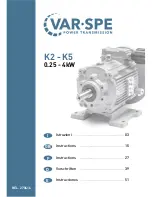
10.9
Section 10
Inspection and Reconditioning
10
Ring failure is usually indicated by excessive oil
consumption and blue exhaust smoke. When rings fail,
oil is allowed to enter the combustion chamber where it
is burned along with the fuel. High oil consumption can
also occur when the piston ring end gap is incorrect,
because the ring cannot properly conform to the
cylinder wall. Oil control is also lost when ring gaps are
not staggered during installation.
When cylinder temperatures get too high, lacquer and
varnish collect on pistons causing rings to stick which
results in rapid wear. A worn ring usually takes on a
shiny or bright appearance.
Scratches on rings and pistons are caused by abrasive
material such as carbon, dirt, or pieces of hard metal.
Detonation damage occurs when a portion of the fuel
charge ignites spontaneously from heat and pressure
shortly after ignition. This creates two flame fronts
which meet and explode to create extreme hammering
pressures on a specific area of the piston. Detonation
generally occurs from using low octane fuels.
Preignition or ignition of the fuel charge before the
timed spark can cause damage similar to detonation.
Preignition damage is often more severe than
detonation damage. Preignition is caused by a hot spot
in the combustion chamber from sources such as:
glowing carbon deposits, blocked fins, improperly
seated valve, or wrong spark plug. See Figure 10-7 for
some common types of piston and ring damage.
Replacement pistons are available in STD bore size,
and in 0.08 mm (0.003 in.), 0.25 mm (0.010 in.), and
0.50 mm (0.020 in.) oversizes. Replacement pistons
include new piston ring sets and new piston pins.
Service replacement piston ring sets are also available
separately for STD, 0.25 mm (0.010 in.), and 0.50 mm
(0.020 in.) oversized pistons. The 0.08 mm (0.003 in.)
oversize piston uses a STD ring set. Always use new
piston rings when installing pistons. Never reuse old
rings.
The cylinder bore must be deglazed before service
ring sets are used.
Abrasive Scratched Rings
Stuck, Broken Rings
Overheated or Deteriorated Oil
Scored Piston and Rings
Figure 10-7. Common Types of Piston and Ring Damage.
Содержание COMMAND CV11
Страница 1: ...1 COMMAND SERVICE MANUAL VERTICAL CRANKSHAFT CV11 16 CV460 465 CV490 495...
Страница 20: ...2 4 Section 2 Special Tools...
Страница 28: ...4 4 Section 4 Air Cleaner and Air Intake System...
Страница 54: ...6 6 Section 6 Lubrication System...
Страница 109: ...9 15 Section 9 Disassembly 9 Regulating Pin Governor Gear Figure 9 53 Removing Governor Gear...
Страница 110: ...9 16 Section 9 Disassembly...
Страница 146: ...1 COMMAND SERVICE MANUAL VERTICAL CRANKSHAFT CV11 16 CV460 465 CV490 495...
Страница 148: ......
















































